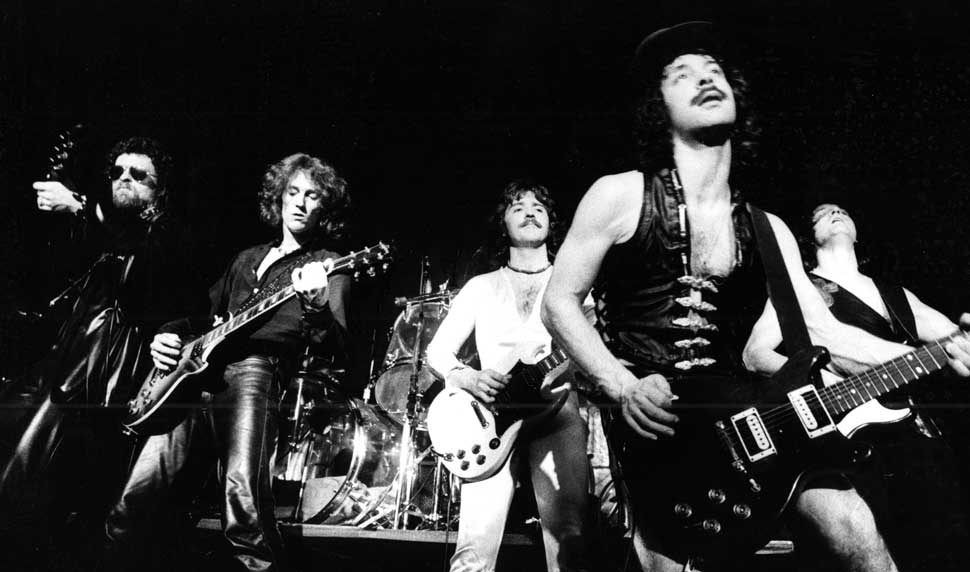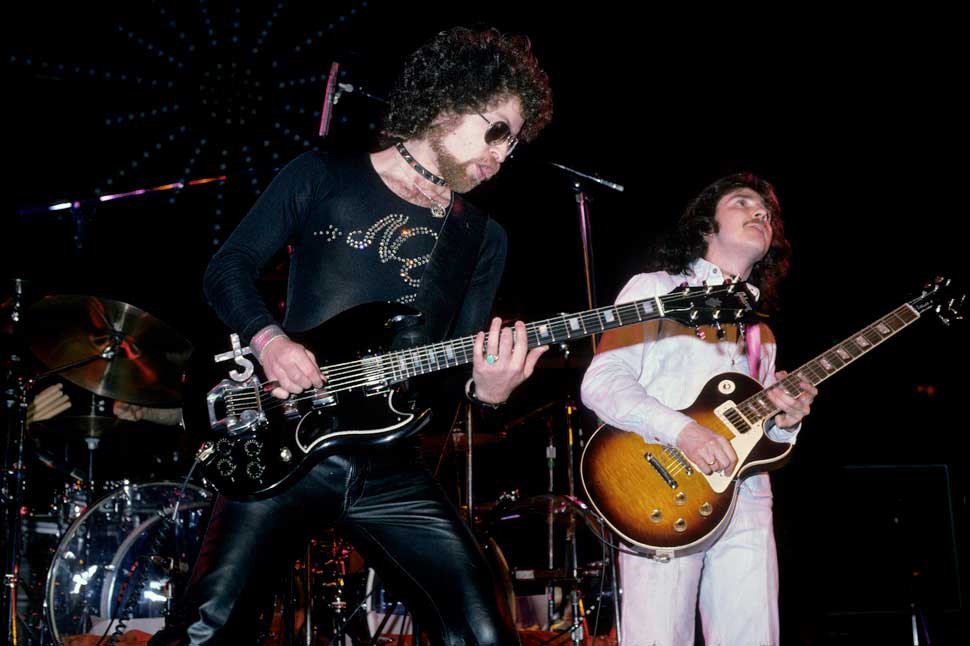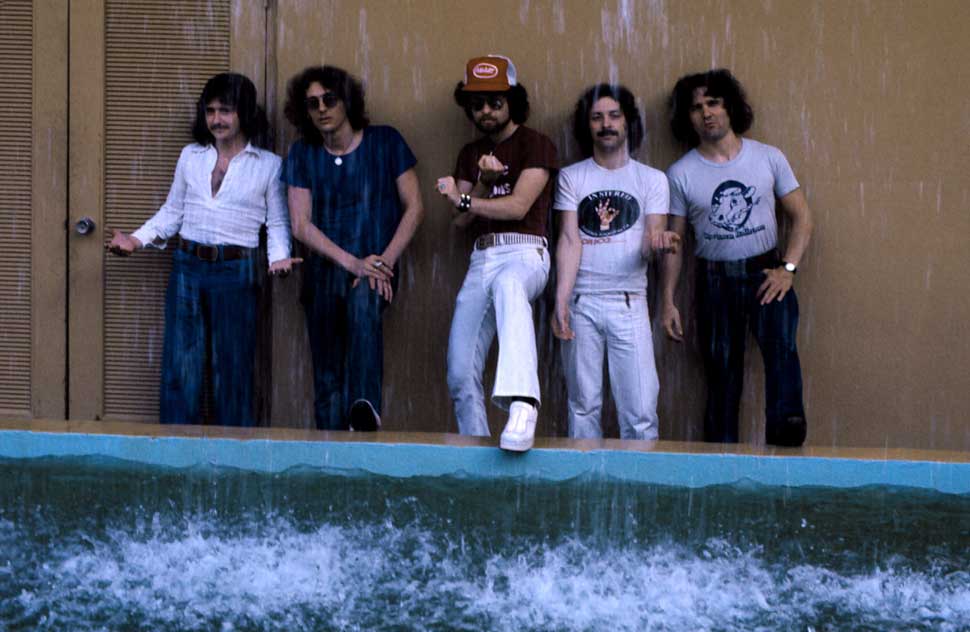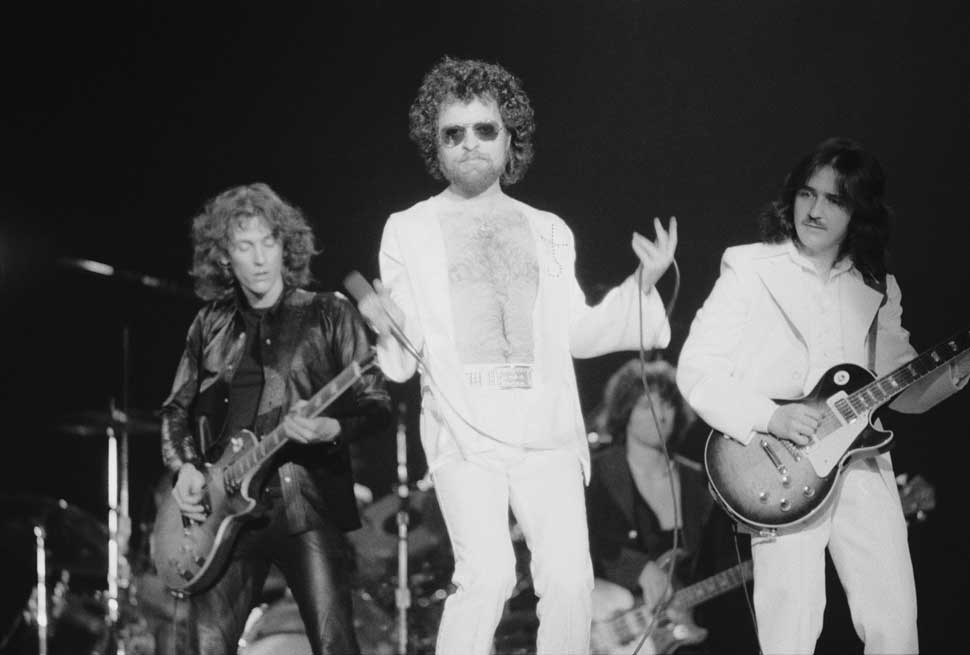In the summer of 1976, Blue Öyster Cult were not just an American arena-rock band in cream suits and aviator shades, they were a cultural phenomenon. Their breakthrough album Agents Of Fortune was released in the spring of 1976 and spawned a monster hit that we’re still reeling from 30 years later. (Don’t Fear) The Reaper’s ghostly autumnal guitar line beckoned like a skeletal finger as temperatures soared and Son of Sam haunted the backstreets and alleys of New York City. It was a weird and beautiful song for a desperate and stressed-out nation. Kiss kept the kids happy with lunchboxes, and pop metal and disco numbed like a new drug in the inner cities, but Blue Öyster Cult were the brooding kings of the teenage wasteland.
BÖC were men of mystery, wrapping their proggy thunder rock in nearly impenetrable sci-fried lyrics about harvesters of eyes and silverfish imperatrixes, hiding their human faces behind lasers and motorcycles and mirror shades, carefully cultivating a sinister image that hinted at exotic drug experimentation and dark occult practices. They were the original stoner rock band, mixing up a lethal cocktail of ancient witchcraft and technical ecstasy, and jacking it all straight into the pleasure centres of all the heavy metal kids of the me-first decade.
Guys who worked on their vans all day and lost their virginity in the woods to the local acid queen during an all-night beer bash would listen incessantly to mysteriously titled BÖC albums like Secret Treaties and Tyranny And Mutation, scanning the covers for hours, searching for hidden symbols and arguing over what, exactly, a ‘screaming diz-buster’ was. Blue Öyster Cult were the belching biker beasts that destroyed the Summer of Love. At least, that’s how it looked from the back of the van…
As with most rock’n’roll stories, the truth could not possibly be as brain-melting as the adolescent super fantasy. In this case, the truth is almost comically anticlimactic. Blue Öyster Cult were not warlocks or space bosses or even backyard Satanists, they were engineering students and fantasy-novel readers from upstate New York who started their musical lives together as a jam band called Soft White Underbelly in 1967. Hippies, really, but hippies with vision – and two hotshot, first-generation gonzo rock writers scribbling endless pages of freaky lyrics for them.
Richard Meltzer and Sandy Pearlman both wrote for the seminal 60s rock magazine Crawdaddy, and both went on to long and varied careers in journalism and music production, but they will forever be remembered as the architects of Blue Öyster Cult’s ride on the hot rails to Hell.
Not only did the two pen such memorable lines as ‘Got a whip in my hand, baby/And a girl or a husky at leather’s end’ (I’m On The Lamb…) and ‘Three thousand guitars/They seem to cry/My ears will melt/And then my eyes’ (Cities On Flame…), but Meltzer also used his considerable power within the press to write increasingly implausible tales of Blue Öyster Cult’s debauched madness on the road. Pearlman went so far as conjure up distinct visual images, like lead singer Eric Bloom’s sleazy leather-man look and Buck Dharma’s shiny white suits. Oh, and he came up with the name Buck Dharma, too.

A group of rock’n’roll intellectuals, managed by the natural enemies of most other bands: smart-ass journalists. A rocking contradiction. Were BÖC a clever ruse? Marshall-stack performance art? Or, beneath that soft white underbelly, were they really the bum-trip shock troopers they seemed to be, here to rock you – in the words of their 1975 live album – On Your Feet Or On Your Knees, whichever came first?
“That’s me, baby. I’m the dark side of 70s rock.” BÖC frontman Eric Bloom, calling from his home in New York, chuckles when I tell him what the main thrust of my story is. He is about to puncture gaping holes in my preconceptions. I tell him about older friends I have who were in their late teens during BÖC’s biggest years, in the mid-to-late 70s; about their Cronos-logo tattoos and druggy meditations on nonsensical wordplay riffs like Wings Wetted Down, and Bloom’s mysterious ‘Stun Guitar’, and lasers so powerful they could make you go blind if you looked at them directly. I tell him I was only seven years old when (Don’t Fear) The Reaper first hit the airwaves, that it scared me to death, and that older kids in the neighbourhood warned me, in hushed tones, that BÖC were “heavily into the occult”.
“Well, we were definitely heavily into the literature,” Bloom explains, “but we didn’t practise anything. That’s one thing that was smack-dab correct about us. I remember one time we had to do an interview in the dressing room after a gig; I think this was in 1980. The reporter walks into the dressing room, looks at us and says: ‘What’s going on here? Is this a set-up?’. I said: ‘What do you mean?’. And he says: ‘Well, you’re all reading books!’. Well, yeah, that’s what we do. He thought it was like when you have a hot date and you hide all your Playboy’s and put intellectual books out to impress her. He didn’t believe we really did like to read books.”
Al Bouchard was Blue Öyster Cult’s drummer from their days as Soft White Underbelly until 1981, when he was unceremoniously fired, mid-tour. He also claims that the band was more erudite than their peers in the arena-rock sweepstakes. “Yeah, I’d say we were intellectuals. Eric Bloom was the one with his nose closest to the street but he went to college, too. We all got it together playing in college bands. College was the cultivating medium for the band.”
I ask him if they thought the less-educated bands in their circuit seemed like cave-dwelling dummies to them. “Like Iggy and The MC5? Yeah. They sorta did. It didn’t matter, they were still really good, but we were a much different band. We were ‘the thinking man’s rock band’.”
A big part of the ‘thinking man’s band’ concept sprang from the fertile mind of Sandy Pearlman, often considered the Svengali of BÖC. Bouchard recalls how the band chanced upon him: “I remember before I ever met Sandy Pearlman, me and Buck Dharma were going to the same college [Clarkson] studying engineering. One of the other fellas bought a copy of this magazine they found in New York City called Crawdaddy, and in it [future Springsteen manager] Jon Landau had written a review of this band Blues Project that we were all very taken with at the time. He had given them a bad review, and we ended up tearing up the magazine and flushing it down the toilet. And, lo and behold, just a few months later, not only are we forming a band with two of the writers for Crawdaddy, but they’re getting us to write reviews for the magazine as well.”

Eric Bloom didn’t join BÖC officially until 1969, but he moved in with the band a year earlier. “When I moved into the band house in 1968, Meltzer and his girlfriend were living there. Pearlman was in and out on a daily basis. The band was playing in the basement. Patti Smith was around a lot – I believe she was dating Sam Shepard, the playwright, at the time. I guess they broke up and she started dating Allen Lanier, our bass player. They ended up living together for many years. Anyway, it was a real hippy kinda scene. Meltzer and Pearlman were writing, and there were piles of manila folders full of lyrics lying around, so everyone was taking these piles of lyrics and writing music to them. And that’s how the band really started.”
When I mention that The Aesthetics Of Rock author Meltzer is sometimes cited as the mastermind behind BÖC’s dark fantasy, Bloom laughs. “I don’t know about Richard being a mastermind, he was just a character around the house who wrote a lot of lyrics. But Sandy really had a Platonic idea of what Blue Öyster Cult should be. He had his own vision: ‘the American Black Sabbath’ or ‘the thinking man’s rock band’. It certainly got us off the ground, his push.”
“The lyrical content was all Sandy Pearlman’s doing,” Bouchard agrees. “He had a vision of us as this black humour kind of thing, pessimistic and dark, but with lyrics filled with puns and oblique references to other disciplines, like science and maths. Sandy is a true intellectual. I’m still amazed by some of the stuff he came up with us for us.”
Having two prankster wordsmiths around helped in other ways as well. “Sandy and Richard were writers, so to help promote us they’d make up shit about us.” Bloom says. “Meltzer wrote an apocryphal article about us in some rock magazine that was totally tongue in cheek. He wrote that we played at the Mount Rushmore rock festival. Of course, there was no such thing. But he said that the highlight of the show was when Eric Bloom jumped off of George Washington’s nose. A couple of years later, we’re driving somewhere in America in our van. We see some poor guy hitch-hiking on a two-lane blacktop, so we picked him up. ‘Are you guys a band?’, he asks us. ‘Yeah’, we tell him: ‘We’re Blue Öyster Cult’. The guy says: ‘No kidding! I was at the Mount Rushmore festival!’. He said he saw my jump off the nose…”
Another important aspect of the band Pearlman developed was their distinctive look, in particular Bloom’s natty biker threads. “He took me to a gay store in Manhattan,” Bloom remembers, “and he said: ‘This is where you buy leather clothes. They don’t sell this stuff in Bloomingdales’. It seems pretty normal now, but not in 1971,” he laughs. “I got my first outfit from Leatherman on Christopher Street.”
I ask Bloom if he ever thought the leather might have pegged him as a gay icon. “Well, Elvis wore the same outfit,” he says. “When I put that stuff on I felt like Batman; nothing gay about it. I just felt very transformed when I put the clothes on. And I always wore sunglasses, even when I was 13 years old, so that was easy. The artist Robert Mapplethorpe used to make my jewellery. It all came together nicely – and the alternative to me was Buck, in the white suit.”
Eric Bloom, then, was the original leather guy, not Rob Halford. “I had a motorcycle on stage before him, too,” Bloom adds.

Pearlman presented the band with readymade stage names, which is how Donald Roeser became Buck Dharma. The rest of BÖC declined to adopt their new monikers, except for Bouchard, whose new name just wouldn’t take. “I was Prince Omega. I really liked it. It wasn’t because I didn’t like it that it didn’t stick.”
Loony concepts in place, BÖC spent the early 70s honing their craft on stage. “Our first tour ever was opening for The Byrds and the Mahavishnu Orchestra,” Bloom remembers. “You could not have had a more eclectic show. We did not do very well at all. We had to regroup and think of a new image, a new way of thinking and a new way of playing if we were going to succeed at all. We had a period of about six months where we just tore down the band and built it back up again. We put more of an edge on everything and that paid off. In mid-72 we got offered to do a run with Alice Cooper. Our first album was just about to come out. Alice liked us and off we went. We ‘broke’ on that tour.”
Inspired by Alice’s ‘evil’ theatrics and stage presence, BÖC began developing some of their most enduring trademarks – the Stun Guitar, for example.
Eric Bloom not only sang, glowered and wore cool gay biker clothes, he also sometimes picked up an axe, adding to the towering pile of riffage in BÖC’s trademark guitarmy. But his instrument was not like the others. Oh no. Bloom played the Stun Guitar. And the Stun Guitar was as mysterious as it was powerful. As latter-day BÖC lyricist John Shirley explains: “The secrets of the Stun Guitar are protected by four powerful, steroid-inflated eunuchs who stand with swords crossed at the gates to the Stun Guitar vault. Bones whiten in a pile at their feet.”
At least that’s the horror author’s version. The guy who actually played the Stun Guitar has a less florid explanation: “I used to play through a customised fuzzbox and I called it the Stun Guitar. I got the name from Star Trek. But that’s me, I’m a total sci-fi nerd.”
Nerds or not, Blue Öyster Cult continued to gain ground in the US and Europe with dense, keyboard-laced rock that Pearlman referred to as ‘heavy metal’ but was more like decadent biker art-prog. Five albums and seven years into their career, they finally achieved real success with 1976’s Agents Of Fortune album, which spawned the monster hit (Don’t Fear) The Reaper, and brought them fame, if not fortune.
“Rich? You mean in dollars?” Bloom laughs. “No. You’ve got to remember, ticket prices were much lower back then. You couldn’t get $150 for a seat like The Who or Billy Joel get now.”

Bouchard at least got to upgrade his transportation fleet. “I had cars before, but they were all used ones,” he says. “So when …Reaper came along I bought two new cars: a Toyota and a Honda.”
No Rolls Royce?
“No,” he deadpans. “There was a gas crisis.”
As the 70s wore on, BÖC began to reject the dark image Pearlman and the record companies had saddled them with. Gone was the biker doom and crunching panic rock. The band began experimenting with poppier sounds and less dense imagery. “Pearlman wanted us to be faceless,” Bloom says. “He thought it was better. That was one of the reasons we rebelled against that in the mid-70s. We told Columbia, our record company, that we were sick and tired of the zippered-leather torture stuff we were getting in the press.”
Bouchard agrees: “We were basically playing a part. The songs were in the first person but they weren’t about us. We were actors playing a part.”
So, there was no real menace behind the message? “Well you can’t just dress up and fake it. I think I was more into it than the other guys. I did revel in it quite a bit – and it was fun. But I would also read stuff like: ‘I wouldn’t want to meet up with Eric Bloom in a dark alley’, which is kinda silly because I’m 5’7” and I weigh 135 pounds. But, you know, I took martial arts for years and I always had motorcycles, it’s not like it was all crapola. But people thought my house was full of leather and spikes; far from it. It was all a fun, comic-book kinda thing for me.”
You really couldn’t conjure up a more comic-book gimmick than lasers that shoot at the audience, which became BÖC’s post-Reaper trademark. There are people in my neighbourhood who still shuffle around in a murky haze, damned forever by the blinding beauty of BÖC’s infamous light show. At least that’s what they mutter between bong hits. And, from what Eric Bloom tells me, there’s a reason so many minds were blown.
“‘Mind-blowing’ is not enough of an adjective to describe those lasers. It was like dropping a nuclear bomb on the audience,” he says. “We did stuff that cannot be done [now] because it’s illegal. We were the test case for having lasers on tour. The Carter administration sent scientists to our gigs. After our tour, they wrote a three-inch-thick report on what can and cannot be done with lasers on stage.”
The idea for the laser show was sparked when Sandy Pearlman took Bloom to see a performance artist named David Enfante in Manhattan in 1976. Enfante was experimenting with lasers and putting on mixed-media shows in his loft. “David had these lasers that moved to the sounds on a tape recorder,” Bloom explains. “Nobody was doing anything like this at the time. He was a scientist. He developed this fibre-optic wiring, which I ended up wearing so it would look like the laser was coming out of my hand. Light would shoot out of my hand and hit the mirrorball on the ceiling.”
The band developed a laser light show based on Enfante’s designs, and took it on the road from 1976 to 1980, but they were plagued with technical problems and the cost of maintaining the lasers was astronomical. “We had to stop doing it, because it was killing us,” Bloom says. “These things were not made to be put in the back of a truck. Every time they broke, it would cost $6,000 to fix. It was just crazy.”

What happened to the lasers has always been open to speculation. There are fantastic rumours that the US government bought them to develop into high-tech weapons, or that they now sit somewhere in the Smithsonian Institute, curious relics from the dinosaur-rock era. According to Bloom, the truth is less compelling. “I think Sandy Pearlman palmed them off on Black Sabbath,” he laughs.
For Blue Öyster Cult 1981 was a tempestuous year. They released the Fire Of Unknown Origin album in May, __ which resulted in two minor hits: the dark pop Burnin’ For You and the campy Joan Crawford.
To promote them, they made ultra-low-budget video clips that were shown sporadically on MTV. Burnin’ For You took the concept quite literally, by featuring a horny teen in a car who combusts into a ball of flames from sexual frustration. “We did those videos in 24 hours,” says Bloom. “One day; no sleep. That was the only way we could do it, because we had no budget. I think we made both of those videos for $20,000.”
The singles gave the band some much-needed momentum and BÖC hit the road, touring with Foghat in the US and then heading to the UK for a series of summer dates, culminating in the Monsters Of Rock festival at Castle Donington. Bouchard was let go during the UK tour, and a roadie took his place for BÖC’s appearance at Monsters. It was a disastrous show for the band, who were plagued with such bad sound that rumours circulated that their set was sabotaged by headliners AC/DC. BÖC were presented with a memorial plaque after the set – Eric Bloom smashed it to bits. It was an ugly time.
Bouchard recalls his abrupt dismissal after a dozen years with the band: “We were going to England and, before we left, the guys said: ‘The band’s wives don’t want you to bring your girlfriend.’ They didn’t like her and said she couldn’t ride in the bus with the rest of us. So I said: ‘Okay, I’ll just rent a car and drive around England, no problem’. I’d never done it before, but how hard can it be? Well, it was hard. It’s all confusing there and I got lost a few times.”
After one tense show, when Bouchard didn’t make it onto the stage until the last three songs, the band had enough. “After the gig, they started berating me about being late. I said some things I probably shouldn’t have, and they canned me. Looking back at it, I probably could have handled it a lot better than attacking their manhood. Later on I apologised but the damage had already been done.” After leaving BÖC, Bouchard went on to pursue a solo career. Meanwhile, the rest of the band ploughed ahead through the 80s in an increasingly more difficult musical climate.
“Disco came along, punk came along, metal came along and what we were doing started to look a little archaic,” Bloom admits. “By 1985, 1986, we had stopped filling up big places. We had a tremendous run, but we went from being the number one band to a certain generation, to the ‘Where are they now?’ file. It had become apparent that we could no longer operate the same way, and we were not going to reinvent ourselves every year-and-a-half, like Madonna.
“Sony dropped us in 1988 and we had to find a new label. Allen Lanier left the band for a while, which left just Buck and I to continue on, and we didn’t get another record deal until the mid-90s, when we signed with Sanctuary. We did three records with them and they did pretty well. About that time, we started getting good gigs again. The places weren’t as big as they used to be, but people were coming out to see us and it all started picking up again.”
In April 2000, US comedy show Saturday Night Live aired a sketch that featured a satirical recreation of the …Reaper studio sessions, with Christopher Walken as a manic producer demanding “More cowbell!” on the track. Six years later, you can still get “More Cowbell!” t-shirts and mugs, while the sketch is acted out by others on youtube.com. Almost overnight, BÖC had been rediscovered by an entire new generation.
“Not only is …Reaper the only song by us they know,” Bloom sighs, “but they only know it because of the SNL sketch.” Still, it’s testament to the song and the band’s staying power. BÖC is now [in 2023] in its second half-century of existence, and continues to perform shows with two original members: Bloom and Buck Dharma. “It’s not a bad job,” Bloom chuckles. “Not a bad job at all.”
But what of all the gnawing darkness? What about the flaming telepaths, the cagey cretins, the cities on fire with rock’n’roll? Were all the primitive blue-ink tattoos and blotter acid trips all for nought? Did Blue Öyster Cult just bluff their way through the sick 70s?
“They had an aura of occult weirdness because Pearlman deliberately evoked that with ambiguous lyrics that had a flavour of Aleister Crowley, but didn’t usually get into specifics,” John Shirley says.
“Our lyrics were a little different,” is all Bloom will offer. “We had Patti Smith writing for us, Michael Moorcock, John Shirley and Richard Meltzer, so a lot of our lyrics are a little strange.”
Bouchard is just as vague: “Even Eric Bloom will tell you he doesn’t know what it all means. But it all means something, just not necessarily what you want it to or what you think it means. What it all adds up to I’m really not quite sure, but it’s more than just a bunch of words, that’s for certain.”
And so it ends like it began: shrouded in mystery. Yes, Blue Öyster Cult may have been just college boys with guitars back in 1969 but, five decades on, their bizarre odes to ‘Beers and barracuda/Reds and monocaine’ still inspire writers, filmmakers and freaks to delve ever deeper into the cosmic rabbit hole, stretching rock’n’roll into twisted shapes and finding blinding truth in crazy old hippy ramblings. Reaper be damned – the Cult continues.
This original version of this article appeared in Classic Rock #96, Summer 2006.

